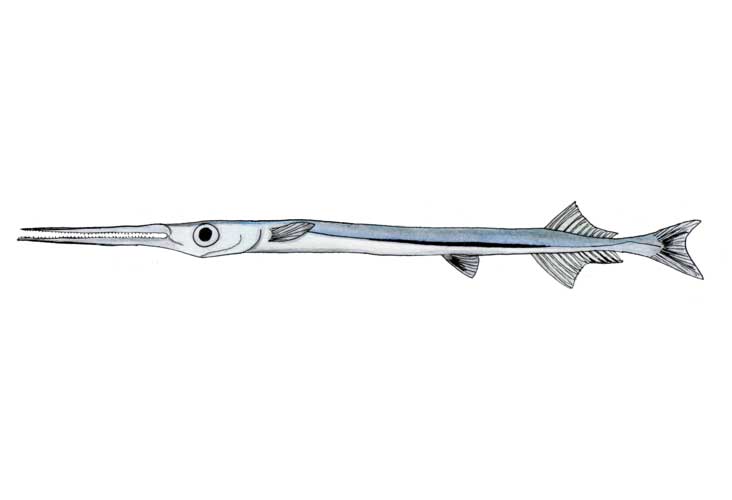Cladus: Eukaryota
Supergroup: Opisthokonta
Regnum: Animalia
Subregnum: Eumetazoa
Cladus: Bilateria
Cladus: Nephrozoa
Cladus: Deuterostomia
Phylum: Chordata
Subphylum: Vertebrata
Infraphylum: Gnathostomata
Superclassis: Osteichthyes
Classis: Actinopterygii
Subclassis: Neopterygii
Infraclassis: Teleostei
Superordo: Acanthopterygii
Ordo: Beloniformes
Subordo: Belonoidei
Superfamilia: Scomberesocoidea
Familia: Belonidae
Genus: Platybelone
Species: Platybelone argalus
Name
Platybelone argalus (Lesueur, 1821)
Synonyms
* Belona argalus Lesueur, 1821
* Belone platyura Bennett, 1832
References
* Lesueur, C. A. (1821) Observations on several genera and species of fish, belonging to the natural family of the Esoces. Journal of the Academy of Natural Sciences, Philadelphia 2 (pt 1): 124-138, 2 pls.
Links
* Platybelone argalus Report on ITIS
The keeltail needlefish, sometimes called the keeled needlefish, is a tropical fish of the family Belonidae. It was described by the French naturalist Charles Alexandre Lesueur in 1821.
Description
Keeltail needlefish, like all needlefish, closely resemble North American freshwater gars (family Lepisosteidae). It is most recognized by the large, flat keels-like structures running on either side of the tail[1]. They have 12 to 15 rays on their dorsal fins, and 17 to 20 rays on their anal fin. Keeltail needlefish have gill-rakers, their caudal peduncles have lateral keels[2], with a lateral line running ventral to it, and grow up to 50 cm long [3] The keeltail needlefish's top jaw is also smaller than the lower one[1].
Distribution and habitat
Keeltail needlefish are found in the western Atlantic ocean between North Carolina and Brazil, this includes the Gulf of Mexico, the Bahamas, and the Caribbean sea[4]. In the Indian ocean, they are known off of east Africa,with range continuing into the Pacific reaching the Hawaiian islands and continuing north to the Ogasawara Islands[5].Keeltail needle fish have also been found around the Arabian Peninsula, in the Red sea and Persian gulf [5] They usually occur offshore and are abundant around islands [6]. They school in sheltered parts of reefs[7], feeding mainly on smaller fish. Keeltail needlefish are egg-laying, attaching their eggs to floating objects with specialized tendril-like structures on the egg's surface [8].
Subspecies
There are seven known subspecies of keeltail needlefish, each being found in a specific region.[9][10][11][12][13][14][15] Some of the most recognized subspecies are Platybelone argalus platura, most common in the Red Sea and Persian Gulf;[5]Platybelone argalus platyura, known from the rest of the Indo-pacific; and Platybelone argalus argalus from the Atlantic.[5]
References
1. ^ a b REEF FISH Identification FLORIDA CARIBBEAN BAHAMAS; Humann, Paul and Ned Deloach; New World Publications Inc., Jacksonville, Fl; pp. 58-59
2. ^ "Fishbase.org entry on Keeltail needlefish". http://www.fishbase.org/Summary/SpeciesSummary.php?id=973. Retrieved 2008-05-14.
3. ^ Claro, R., 1994. Características generales de la ictiofauna. p. 55-70. In R. Claro (ed.) Ecología de los peces marinos de Cuba. Instituto de Oceanología Academia de Ciencias de Cuba and Centro de Investigaciones de Quintana Roo.
4. ^ Robins, C.R. and G.C. Ray, 1986. A field guide to Atlantic coast fishes of North America. Houghton Mifflin Company, Boston, U.S.A. 354 p.
5. ^ a b c d "mcr.lternet.edu entry on Keeltail needlefish". http://mcr.lternet.edu/education/encyclopedia/speciescard.php?refID=3&CreatureID=38. Retrieved 2008-06-08.
6. ^ Cervigón, F., R. Cipriani, W. Fischer, L. Garibaldi, M. Hendrickx, A.J. Lemus, R. Márquez, J.M. Poutiers, G. Robaina and B. Rodriguez, 1992. Fichas FAO de identificación de especies para los fines de la pesca. Guía de campo de las especies comerciales marinas y de aquas salobres de la costa septentrional de Sur América. FAO, Rome. 513 p. Preparado con el financiamento de la Comisión de Comunidades Europeas y de NORAD.
7. ^ Kuiter, R.H. and T. Tonozuka 2001 Pictorial guide to Indonesian reef fishes. Part 1. Eels- Snappers, Muraenidae - Lutjanidae. Zoonetics, Australia. 302 p.
8. ^ Breder, C.M. and D.E. Rosen, 1966. Modes of reproduction in fishes. T.F.H. Publications, Neptune City, New Jersey. 941 p.
9. ^ Belonidae (pp. 258-260), Scomberesocidae (pp. 261-262), Exocoetidae (pp. 263-267), Hemiramphidae (pp. 268-269). In: Hureau & Monod 1973 [ref. 6590]. Clofnam v. 1.
10. ^ Family Belonidae Bonaparte 1832 -- needlefishes. California Academy of Sciences Annotated Checklists of Fishes No. 16: 1-22.
11. ^ Review of marine belonids [needlefishes] of the western Pacific and Indian oceans. Trudy Instituta okeanologii im. P.P. Shirshova v. 84: 3-83. [In Russian. English translation from National Marine Fisheries Service Systematics Laboratory, Washington D.C., translation no. 68.]
12. ^ Mees G.F. (1962) A preliminary revision of the Belonidae. Zoologische Verhandelingen (Leiden) No. 54: 1-96. PDF
13. ^ Neue Wirbelthiere zu der Fauna von Abyssinien gehörig. Fische des Rothen Meeres. Frankfurt-am-Main. 1-148, Pls. 1-33. [1835:1-28, Pls. 1-7; 1836:29-52, Pls. 8-14; 1837:53-80, Pls. 15-21; 1838:81-148, Pls. 22-33.]. Fische Rothen Meeres 1835-38. [For dates see Sawyer 1952 [ref. 13582].]
14. ^ Shore fishes collected by the "Albatross" expedition in Lower California, with descriptions of new species. Bulletin of the American Museum of Natural History v. 35 (art. 16): 139-181.
15. ^ Catalogue critique des types de poissons du Muséum National d'Histoire Naturelle (suite). Ordre des Beloniformes. Cybium v. 21 (no. 1): 5-35.

